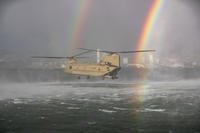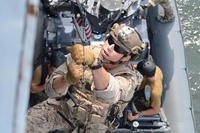For decades, the Tailhook Association was the top professional association for naval and Marine Corps aviators. Its annual Naval Aviation Symposium became one of the biggest and most important gatherings for Navy officers.
What began as a way for current and former military pilots to get together, share stories and reconnect in the mid-1950s grew to a semi-official event within five years.
But it was not long after that, the unofficial after-hours events became the real draw for the Navy's brass. And it all came crashing down in 1991.
That's when allegations emerged that the drunken activities of Tailhook attendees crossed a line, with Navy and Marine Corps officers accused of sexually assaulting 83 women and seven men, according to an official investigation of what happened.
Investigators later said the out-of-control revelry had Hollywood inspiration: "Top Gun." Released five years prior, it had already become a cult classic within the Navy. The free-wielding "Maverick," played by Tom Cruise, gave the impression that this kind of thing was totally fine.
"Some senior officers blamed the younger officers for rowdy behavior and cited a 'Top Gun'
Mentality," according to the investigators' report. "The movie fueled misconceptions on the part of junior officers as to what was expected of them and also served to increase the general awareness of naval aviation and glorify naval pilots in the eyes of many young women."
So what happened?
The Tailhook Association held its 1991 symposium at the Las Vegas Hilton from Sept. 5-7. Still riding high from victory in the recent Gulf War, its 4,000 attendees were understandably jubilant. A full third of the United States' naval aviators were among those attending presentations from defense contractors, panel forums and banquets.
Among the visitors expected to speak were three former Gulf War prisoners of war; the Navy's top officer, Chief of Naval Operations Adm. Frank Kelso; and Secretary of the Navy Henry L. Garrett III.
"Tailhook," as it was informally called, was kind of a big deal.
The real draw for some of the Navy's aviators was the Hilton's third-floor hospitality suites, after the official functions of the symposium had concluded for the day. It was well-known among attendees that the third floor could get rowdy, out of control and crowded with drunken pilots. The hotel's third-floor hallway was even dubbed "the Gauntlet."
The Gauntlet may have been the primary problem for Tailhook '91, but it was by no means the only problem area. It first appeared at the 1986 Tailhook Symposium, and by 1991, it was packed with hundreds of young, mostly male Navy, Marine Corps and Air Force pilots, drinking and singing songs.
Navy squadrons footed the booze bill, which could run upward of $7,000 per suite per day. Officers were drinking from dispensers shaped like a rhino penis while intoxicated attendees were known for stripping down and streaking through the parties. Inside the suites were strippers and scantily clad bartenders, and even porn films were being screened.
Just another night in Las Vegas turned into three nights of booze-fueled revelry that plotted a course south when a woman had to walk down the hallway.
Female Hilton employees were advised to avoid the area at all costs during the Tailhook Convention, but female conference attendees weren't always so lucky. The morning after Tailhook's first night was when the accusations began.
Several dozen women reported being fondled, groped or assaulted after being forced to "run the Gauntlet" during the conference. The first to blow the whistle on the affair was then- Lt. Paula Coughlin. Coughlin later reported that her clothes were ripped off, and she feared being gang-raped before she managed to escape to an empty suite.
The next morning, she had breakfast with her direct superior, Rear Adm. Jack Snyder. She told the admiral what happened to her on the third floor the previous night. His response: "Well, that's what you get for going down a hallway of a bunch of drunken aviators."
That response wasn't acceptable to Coughlin. When she returned to her home duty station of Patuxent River Naval Air Test Center, Maryland, she brought it to Snyder again. The admiral promised to send it up the chain of command through letters, but at the end of September 1991, they had still not been delivered. Coughlin sent the letters herself.
It took just more than a month to get someone to pay attention. By Oct. 11, 1991, the Naval Investigative Service (NIS) opened an investigation into her allegations. By the end of the month, senators like John McCain, a former naval aviator, were discussing the allegations on the Senate floor.
Rear Adm. Snyder would become the first to face the fallout of what would be known as the "Tailhook Scandal." He was relieved of his command of Patuxent River Naval Air Test Center. There was more to come.
The Navy soon cut its connection with the Tailhook Association. The NIS investigation found 25 victims of sexual assault and mentioned four suspects by name. The House and Senate Armed Services Committees weren't satisfied with the result of that investigation and charged the Department of Defense inspector general with conducting one of its own.
On April 23, 1993, the DoD inspector general released its report, finding 83 women and seven men who were assaulted during the Tailhook Symposium. The bulk of the victims were civilians who were unconnected to the military, along with female government employees and military spouses.
Three hundred officers were identified as having committed some sort of offense over the weekend, but only 140 were referred for disciplinary action. None of them went to trial, and most were given non-judicial punishments, fines, official reprimands and, at worst, demotions.
None were charged with sexual assault, instead facing charges of indecent exposure, conduct unbecoming an officer and making false official statements. Coughlin resigned from the Navy in May 1994, amid claims she was being harassed and abused for blowing the whistle on the partiers. She sued both the Tailhook Association and the Las Vegas Hilton.
The Tailhook Association would settle out of court for $400,000, while the Hilton would be found negligent of providing adequate security for attendees. The hotel was forced to pay Coughlin more than $5 million in compensatory and punitive damages.
-- Blake Stilwell can be reached at blake.stilwell@military.com. He can also be found on Twitter @blakestilwell or on Facebook.
Want to Learn More About Military Life?
Whether you're thinking of joining the military, looking for post-military careers or keeping up with military life and benefits, Military.com has you covered. Subscribe to Military.com to have military news, updates and resources delivered directly to your inbox..















